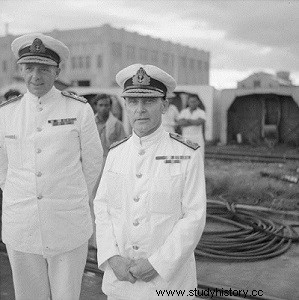
Nobody wanted to give in and, for weeks, the discussions were tight. Eventually Churchill overrode and Repulse and Prince of Wales were sent to fend for themselves as best they could. In Singapore, everyone welcomed this decision, with the exception of some who passed a pessimistic judgment on a fleet so unbalanced since it totally lacked air support. Indeed, Force Z should have included the new aircraft carrier Indomitable, but it had been damaged during its trials in the West Indies and it was under repair. Either way, the R.A.F. had no modern bombers in Malaysia.
That said, even left to themselves, the two buildings constituted in the eyes of many observers a powerful combat force. Certainly, they were very different from each other:the Prince of Wales, brand new battleship, flagship of modern naval construction, the Repulse, survivor of a much earlier generation of combat vessels.
Completed in 1916, it belonged to an era when aviation was not really dangerous and, despite two attempts to modernize it, it still lacked, in 1941, the horizontal armor necessary to protect it against air attacks . It was commanded by William Tennant, future admiral, much admired and loved by his men. The heavily armored Prince of Wales had only been completed in 1941. Slower than the Repulse, with a maximum of 28.5 knots, and larger, with a displacement of 35,000 tons, she had exceptional horizontal armour. Britain's first battleship with quadruple turrets, she was originally to be fitted with 12 356 mm guns, but two had been sacrificed for armor; he had, in addition, sixteen 132 guns, sixty 40 mm anti-aircraft guns, numerous heavy machine guns.
John Leach commanded the Prince of Wales, who, under his command, already had a career full, albeit brief. She had received the baptism of fire against the Bismarck, when she was barely finished (one hundred shipyard workers were still on board during the engagement); he had transported Churchill to Newfoundland for the famous Atlantic Charter meeting with Roosevelt. But one black point:during the battle against the Bismarck, five of her ten guns had suffered mechanical failures, testifying to a worrying lack of development.
In the port of Singapore, the difference between the two ships increased. The Prince of Wales, nicknamed “Unsinkable” or “Churchill's Yacht”, was the star; the visits of the authorities followed one another on board. The Repulse was the "Anonymous". Her name had been concealed at Singapore, with the vain intention of concealing her presence from the enemy and revealing that she was the only important vessel to accompany the Prince of Wales; her crew was consigned on board and were not allowed to mention their whereabouts in private correspondence.
Four destroyers escorted the two battleships. Two of them, the Express and the Electra, were excellent Home Fleet vessels. The other two, the Vampire, of Australian nationality, and the Tenedos, British, had been chosen at the last moment to replace two failing destroyers. The Tenedos had to be quickly withdrawn because its fuel reserves were insufficient for this type of operation.
Admiral Sir Tom Phillips commanded the British Far East Fleet. A former Deputy Chief of the Naval Staff, he was an exceptionally intelligent and capable officer, whom his men referred to as Admiral "Tom Thumb" because of his short stature. Phillips was one of those who did not have excessive confidence in the possibilities of the Z force. As soon as the ships arrived in the port of Singapore, Phillips understood that it would be vain to hope to see them fulfill the mission that they were entrusted with. On December 3, he announced his intention to send the Repulse and two destroyers to Port Darwin, officially for a maneuver cruise, but in reality to study the possibility of using Port Darwin as a base. They set out on December 5, but on the 6th Singapore learned of the presence of a Japanese landing fleet off the southern coast of Indochina and the ships were hastily recalled.
Concern for the security of Force Z grew; even in London, people were more concerned with the fate of the ships than with their mission. The Admiralty suggested that Phillips sail east to join the American Asiatic Fleet; Churchill himself returned to his initial optimism and demanded that "the movements of the fleet be kept secret as soon as possible"; Phillips flew to Manila to confer with U.S. Admiral Hart and come to terms with him on a common naval strategy in the Pacific. in clear skies came news of Japanese attacks on Pearl Harbor, Hong Kong, the Philippines, Thailand and Malaysia.
